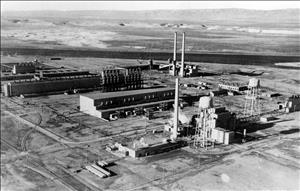In March 1943, the U.S. Army Corps of Engineers begins construction of the massive, and top secret, Hanford Engineer Works along the Columbia River in Benton County. In less than two years, a construction crew that peaks at 51,000 workers constructs three nuclear reactors and many other facilities, along with a new "government city" at Richland. Plutonium produced at the Hanford reactors is used in the first ever atomic explosion at Alamagordo, New Mexico, and in the atomic bomb dropped on Nagasaki, Japan.
As part of U.S. efforts to produce atomic weapons during World War II, President Franklin Roosevelt (1882-1945) created the Manhattan Engineer District (MED) within the Army Corps of Engineers. The MED, headed by Gen. Leslie Groves, was to construct plants to produce the uranium 235 and plutonium 239 that would be used in the weapons. Gen. Groves selected DuPont Corporation, the giant chemical and engineering company, as the prime contractor for the plutonium production complex.
Taking the Site
Army and DuPont officials met in December 1942 to determine criteria for the plutonium production site. Because of the extremely hazardous substances involved, they decided it would be located in the West, away from the population centers of the East Coast and Midwest. The site would need room for a "hazardous manufacturing area" of at least 12 by 16 miles, with no towns over 1,000 people within 20 miles, and no highway or railway within 10 miles. Ample fresh water and dependable electrical supplies were also necessary.
In late December 1942, the three men charged with finding a site that met these criteria -- Army Colonel Franklin T. Matthias and DuPont engineers Gilbert Church and A. E. S. Hall -- visited the dry plains along the Columbia River west of the small towns of White Bluffs, Hanford, and Richland. The three unanimously recommended this Hanford site "as being far more favorable in virtually all respects than any other" (Home Front, 12). Gen. Groves visited Hanford in January and agreed. By February 23, 1943, the government had secretly appraised and condemned the property of 1,200 landowners within the project area, which encompassed 560 square miles, more than a third of a million acres or nearly half the size of the state of Rhode Island.
On March 6, 1943, officials held a mass meeting to notify the owners that their land was being taken for a government project. Residents were given 30 days to move. Due to the secrecy surrounding the atomic bomb, they were told only that the project involved the war effort. Residents organized some protests but eventually complied, although many challenged the low appraised prices the government set on their property. It was difficult to find new homes and farmland in the area, and some displaced residents resented the newcomers who flocked to build the massive project.
Construction Begins
Construction began in March 1943, and proceeded rapidly. The first step was to build a giant camp including barracks, mess halls, and other facilities for the construction workers, who eventually numbered 51,000. These workers built more than 500 structures including three reactors, chemical-separation buildings, fuel-fabrication facilities, laboratories, offices, and underground high-level-waste storage tanks. They constructed 386 miles of automobile road, 158 miles of railroad, 50 miles of power lines and four substations, and hundreds of miles of fencing. The total construction cost was $230 million. The Manhattan Engineer District also built a whole new "government city," with housing for 17,500 people, at Richland, which, before the project began, had been home to only a few hundred.
The building went on amid official secrecy. The government asked newspapers and radio stations not to publicize the work, and they generally complied, although not surprisingly some references to the massive project were published. Local and state officials were not given information about the huge complex being constructed in their jurisdiction, and even most federal officials did not know about the plutonium production. Only after the first atomic bomb was dropped on Japan did local residents and people around the world learn something of the work being done at Hanford, as the U.S. government released the first official account of the Manhattan Project.
From A-bomb to Clean-up
The first reactor at Hanford went critical in September 1944, and the third was operating by early 1945. Plutonium produced at the Hanford reactors was used in the first atomic explosion, at Alamogordo, New Mexico, on July 16, 1945. Plutonium from Hanford was also used in the bomb dropped on Nagasaki, Japan, on August 9, 1945, which killed almost 74,000 people and severely injured another 75,000, out of the city’s 286,000 residents. (The bomb dropped on Hiroshima three days earlier used concentrated uranium, made at Oak Ridge, Tennessee.)
Production at Hanford was cut back after World War II ended. However, it soon geared up again to produce plutonium for nuclear weapons during the Cold War, and the site underwent several significant expansions as additional reactors were constructed. Only after the collapse of the Soviet Union in the early 1990s were most of the major facilities at Hanford deactivated. By then, classified documents released in the 1980s revealed that there had been many extensive releases of radioactivity into the air, water, and ground at Hanford during and after the World War II years. Lengthy and involved efforts to clean up the extensive contamination at the site got underway, as did lawsuits by downwinders and others affected by the contamination. Both are still ongoing in 2003.

